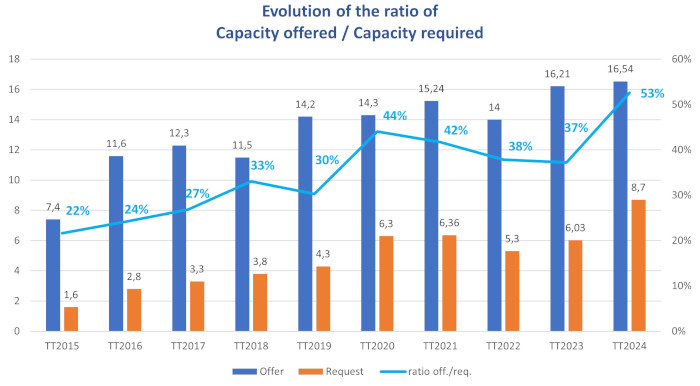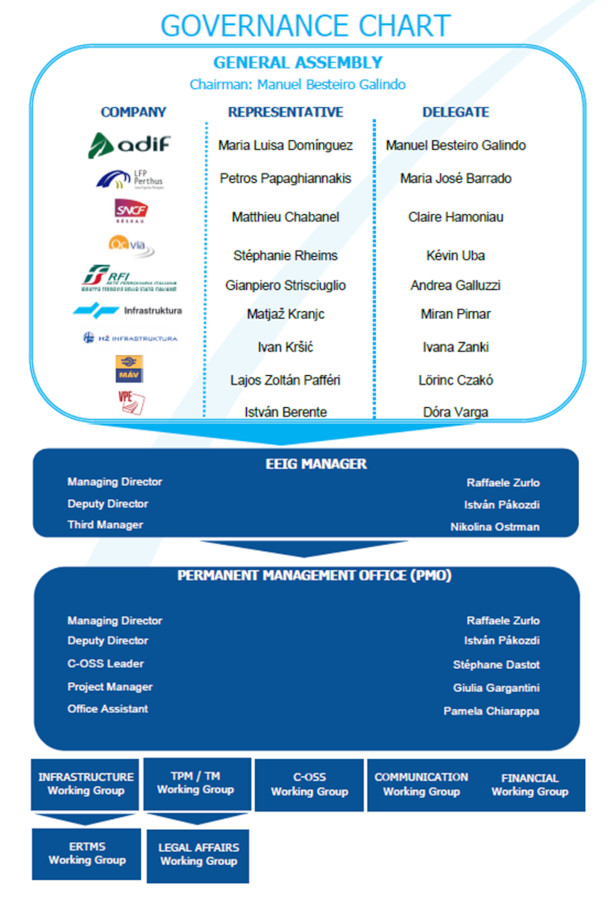Over the years, the Mediterranean Rail Freight Corridor has contributed considerably to the improvement of international cooperation between its Infrastructure Managers and the Capacity Allocation Body (in Hungary there is a separation of roles), which culminated in the important Conference in Zagreb in 2017, at which a Letter of Intent was signed by the respective CEOs containing a number of specific measures aimed at strengthening the development of international freight transport.
One of the Corridor's tasks is to periodically update a market study on observed and expected traffic trends along its route. The Corridor conducted an initial study in 2013, which was subsequently updated in 2016, when Croatia joined the Corridor. The market study contains a series of modal shift projections with medium- and long-term time horizons depending on a number of parameters that determine the modal selection (e.g. cost of rail and road transport, infrastructure developments, etc.). In 2020, the Corridor, in cooperation with the Ten-T Mediterranean Corridor, developed a new study with an analysis of the traffic on the Corridor and future development scenarios based on the assumption of the evolution of certain economic factors and transport policies.
In 2017, the Corridor also completed a study on the last rail mile, aimed at identifying the main infrastructure measures needed to strengthen the performance of the supply chain in relation to the connections between infrastructure manager and terminals.
As of 2019, the Train Performance Management (TPM) Working Group has held a series of meetings with the Railway Undertakings operating along the Corridor twice a year in order to:
- better understand the developments and needs of the rail transport market;
- identify weaknesses and possible corrective actions;
- initiate and conduct joint analyses of the main problems of the railway sector along the Corridor, with particular reference to cross-border transits.
One of the most important studies conducted by the Corridor in recent years is the “Boost on Rail” study developed in 2019 in cooperation with Federchimica, which focused on identifying the factors considered by the chemical sector to be decisive for modal shift.
In 2020, the Mediterranean Rail Freight Corridor carried out a pilot project concerning the implementation of an End-to-End international rail transport control and monitoring function on a sample of bi-national and tri-national international traffic relations.
The main objectives of the project were:
- The proactive involvement of all actors in the railway supply chain (Infrastructure Managers, Intermodal Terminals and Industrial Junctions) together with other important stakeholders (RNE, Industrial Associations and End Users) in the real-time monitoring of trains on a restricted selection of routes;
- The improvement of the quality of the data entered into the European systems, concerning the monitoring of rail traffic, with the integration of data concerning the activities of arriving and departing terminals;
- The regular production of punctuality reports for the monitored flows, shared with all the actors involved, with the aim of identifying improvement actions and defining punctuality targets capable of increasing the share of transported traffic.
Activities to improve circulation at borders
• Villa Opicina Task Force
Since September 2020, due to planned works at the Karavanke Tunnel (on the Austrian-Slovenian border), some of the Koper - Villach traffic has been diverted via Villa Opicina/Tarvisio, resulting in critical management problems for the Villa Opicina facility and the terminals and facilities in the area on both sides of the border. In response to a 32% increase in traffic at the Italian-Slovenian border crossing, the Mediterranean Freight Railway Corridor coordinated a task force made up of the Italian and Slovenian Infrastructure Managers with the objective of jointly monitoring the planning and operational management of freight traffic, sharing the rules for managing cross-border traffic, and setting up a round table with the Railway Undertakings to share actions to improve punctuality at the crossing.
In 2023 and 2024, the Villa Opicina Task Force will continue its activities to streamline railway traffic between Italy and Slovenia. The priority objective is to achieve a significant reduction in the stationing time of freight trains in the Villa Opicina station.
• Modane Task Force
At the border between Italy and France at the Modane facility, with the involvement of RFI and SNCF Réseau, the Corridor has launched the Quality Circle Operation (QCO), an initiative aimed at reducing transit times through the identification of joint initiatives with railway undertakings, also in anticipation of the construction of the new Turin-Lyon link.
• QCO Perpignan - Barcelona
During the meeting held in Madrid between the Mediterranean Rail Freight Corridor and the management of the Infrastructure Manager (IM) ADIF, on 21/06/2023, the “QCO Perpignan - Barcelona” Task Force was launched, with the aim of facilitating and improving cross-border cooperation between the two IMs, ADIF and SNCF Réseau, and all other stakeholders. The priority objectives identified are as follows:
Optimisation of management procedures at Perpignan FI Station
TT Targets 2023:
- Night openings of the LFP on Sat/Sun and Sun/Mon as of TT 2023;
- Night-time openings of ADIF on Sat/Sun and Sun/Mon as of 30/03/2023;
- Application of new standards and procedures in railway traffic management.
Future TT 2024 targets:
- Feasibility study for a third night opening during the week;
- Further optimisation of rail traffic management at Perpignan Station;
- Further development of the QCO BCP Perpignan - Barcelona.


